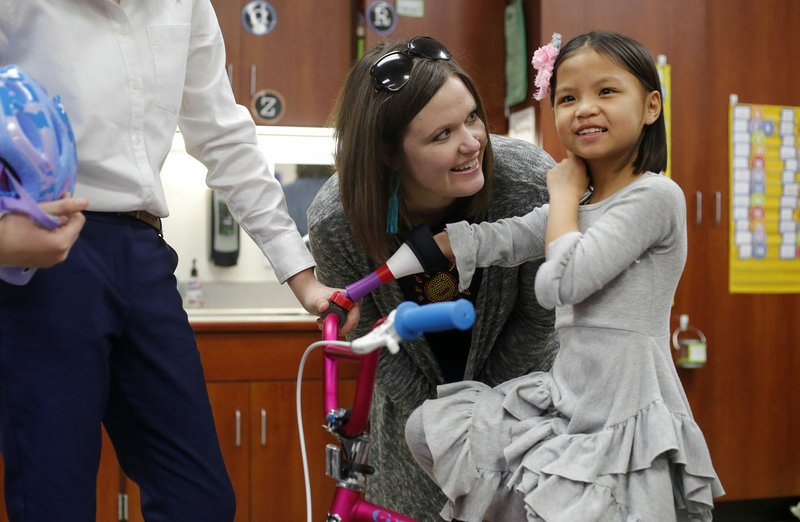SPRINGDALE -- Students have once again used technology courses and district equipment to help one of their own.
Gracie Marvin, a first-grader at Springdale's Shaw Elementary School, on Tuesday received a new bicycle with one end of its handlebar specially fitted for her use. Gracie's right arm stops right about where her wrist would be so a regular bike is tough to steer, especially for someone trying to give up training wheels.
Students in environmental and spacial technology classes, commonly called EAST, at Shaw and Don Tyson School of Innovation spent weeks designing and making a 3D-printed handlebar extension that's cone-shaped, hollow and lined with soft cloth to hold Gracie's arm.
She took the gift for a short test drive down one hallway as students, teachers, members of the media and her parents looked on.
The unexpected crowd left the normally gregarious Gracie bashful and sticking close to her parents, but her mom, Julie Marvin, said Gracie had long yearned to ride a bike just like her cousins and friends.
"I think it's awesome," Marvin said. "I love seeing these kids helping their peer."
Northwest Arkansas students for years have used the technology they learn in school to help others.
Rogers junior high students in 2016 fitted a 3D-printed prosthetic hand for then-kindergartner Austin Bryant, who, like Gracie, was born without the lower segment of one arm. Sonora Middle School students in Springdale last fall used virtual reality headsets to display recreations of treasured memories for residents of the Rocking Chair Inn retirement home.
EAST students at Shaw are working on computer programs to help kids wash their hands thoroughly or stay focused in class, program facilitator Sylvia Hernandez said. The older students with her counterpart at the School of Innovation, Wade Ward, are developing virtual reality games that foster empathy in the player, are hydroponically growing lettuce and are exploring video production, drones and architecture.
"We give them the time, the opportunities, the equipment and the knowledge," sometimes from outside professionals if needed, Ward said.
The emphasis on letting students explore their particular interests and goals led to Gracie's gift. Her fifth-grade cousin, Leah Marvin, brought the idea for the project to her class at Shaw after talking about prosthetics with Gracie's mom.
"I like to help, and I really do like technology," Leah said. She said other projects in the class include a website for learning English and other computer programs.
Leah's class teamed up with Steicy Lopez, a ninth-grader at the School of Innovation who has spent about two years getting experience with 3D printing. She and the other students drew up preliminary ideas for Gracie's prosthesis and designed it on a computer. The final product took about 50 hours in the printer to make.
Even after that work, there's always something to tweak and improve. The prosthesis occasionally popped out of the ball-and-socket joint connecting it to the bike's handlebar, so Steicy said she'll work on strengthening the joint and making spares for Gracie.
"You try again, and you try again," Steicy said.
NW News on 01/24/2018

